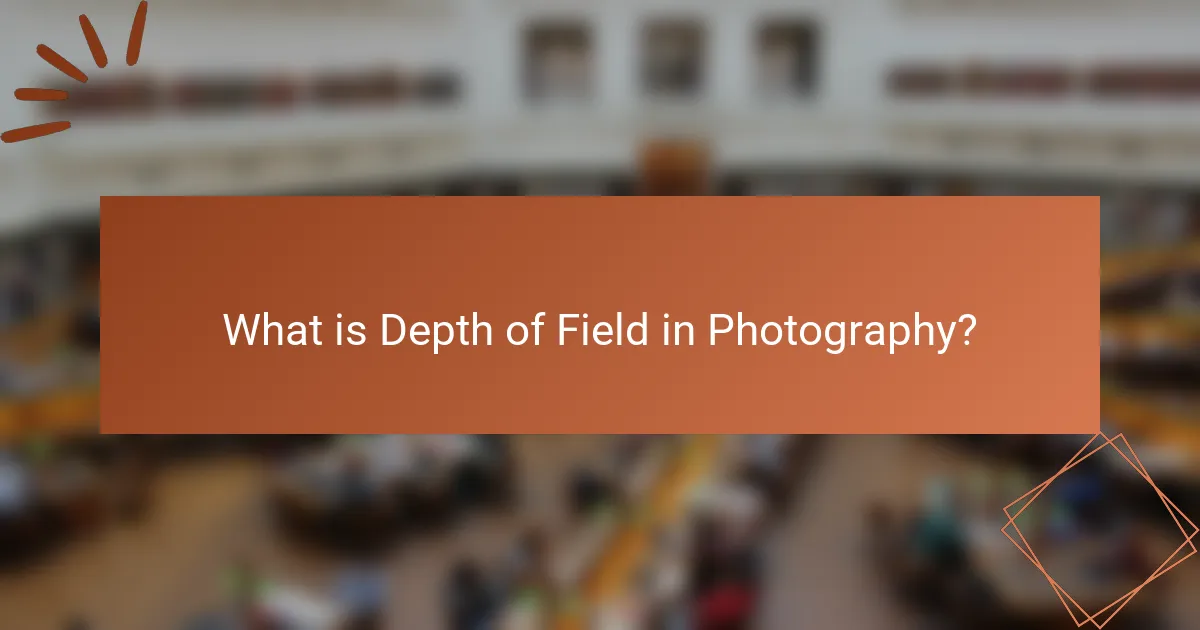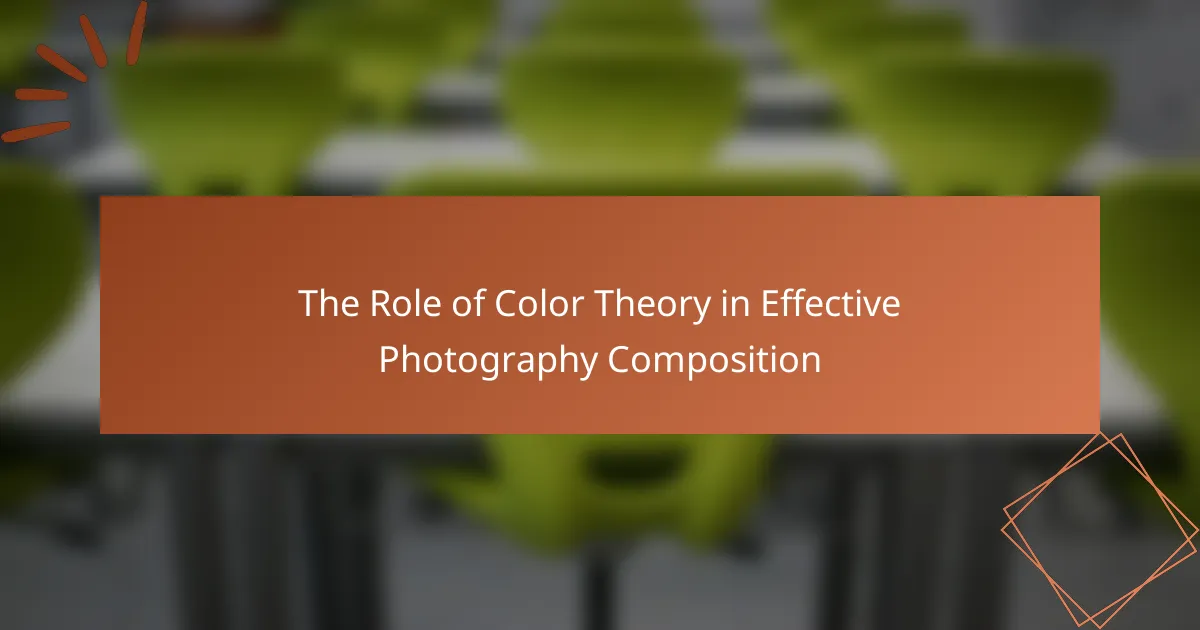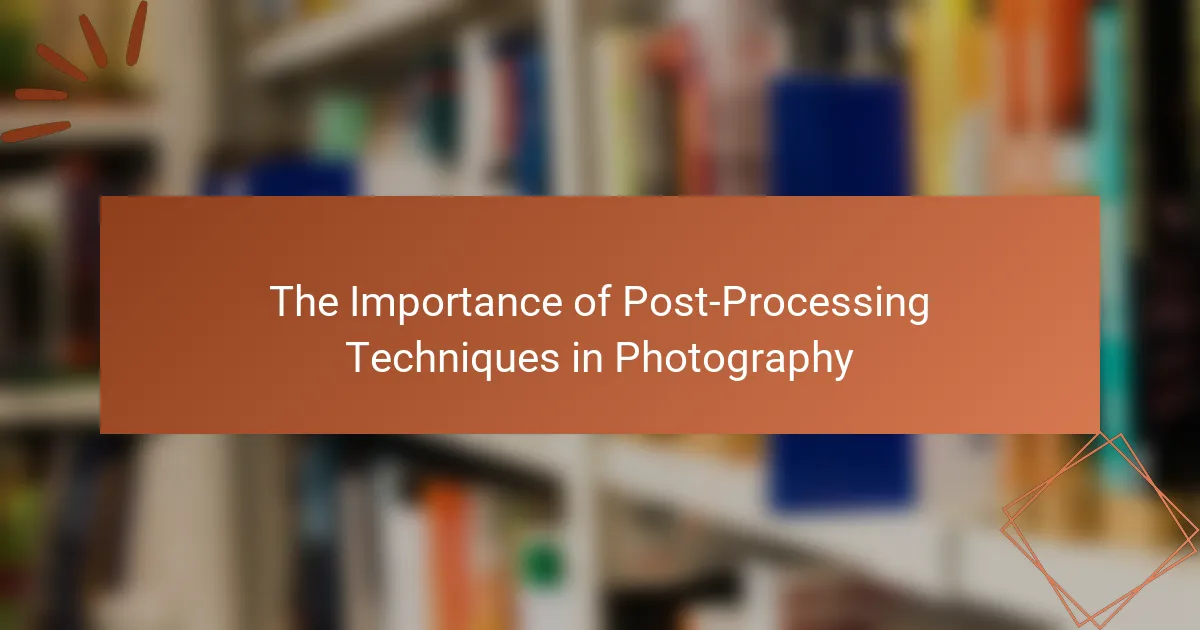Depth of field (DoF) in photography is defined as the range of distance within an image that appears acceptably sharp. It is influenced by three main factors: aperture size, focal length, and distance from the subject. A wider aperture (lower f-number) leads to a shallower DoF, effectively blurring the background and isolating the subject, which is particularly useful for portrait photography. Conversely, a narrower aperture (higher f-number) increases DoF, allowing more elements in the scene to remain in focus, ideal for landscape photography. Understanding these principles enables photographers to make informed decisions that enhance the visual narrative of their images.

What is Depth of Field in Photography?
Depth of field in photography refers to the range of distance within a photo that appears acceptably sharp. It is influenced by several factors, including aperture size, focal length, and distance from the subject. A wider aperture (lower f-number) results in a shallower depth of field, blurring the background. Conversely, a narrower aperture (higher f-number) increases depth of field, keeping more of the scene in focus. Additionally, longer focal lengths tend to produce a shallower depth of field. Close proximity to the subject also decreases depth of field. Understanding depth of field is essential for photographers to achieve desired artistic effects and control focus.
How does Depth of Field affect the overall composition of a photograph?
Depth of Field (DoF) significantly influences the overall composition of a photograph. It determines which elements are in focus and which are blurred. A shallow DoF isolates the subject by blurring the background, enhancing emphasis and creating a sense of depth. This technique is often used in portrait photography to draw attention to the subject’s details. Conversely, a deep DoF keeps more elements in focus, which is ideal for landscape photography. It allows viewers to appreciate the entire scene, from foreground to background. Studies show that varying DoF can evoke different emotional responses. For instance, shallow DoF may convey intimacy, while deep DoF can suggest vastness. Thus, the choice of DoF is crucial for effective visual storytelling in photography.
What are the different types of Depth of Field?
The different types of Depth of Field (DoF) are shallow, deep, and selective. Shallow DoF results in a blurred background, emphasizing the subject. This effect is often achieved with wide apertures. Deep DoF keeps both the foreground and background in focus. It is commonly used in landscape photography. Selective DoF allows the photographer to choose which areas are in focus while others are blurred. Each type serves different artistic purposes in photography.
How is Depth of Field measured in photography?
Depth of Field (DoF) in photography is measured by the distance between the nearest and farthest objects in a scene that appear acceptably sharp. Several factors influence this measurement. Aperture size, focal length, and subject distance all play critical roles. A larger aperture (smaller f-stop number) results in a shallower DoF. Conversely, a smaller aperture (larger f-stop number) increases the DoF. Longer focal lengths also create a shallower DoF, while shorter focal lengths increase it. Additionally, as the subject moves closer to the camera, the DoF decreases. These principles are foundational in understanding how to control focus in photography.
Why is Depth of Field important for photographers?
Depth of Field (DoF) is important for photographers because it determines the range of distance that appears sharp in an image. A shallow DoF isolates the subject by blurring the background, enhancing focus on the main element. Conversely, a deep DoF keeps more of the scene in focus, useful for landscapes. Understanding DoF allows photographers to creatively control emphasis and storytelling in their work. It also influences exposure settings, as aperture size directly affects DoF. Mastery of DoF is crucial in achieving desired visual effects and improving overall composition.
What creative effects can be achieved through manipulating Depth of Field?
Manipulating Depth of Field (DoF) can create various creative effects in photography. A shallow DoF isolates the subject from the background, enhancing focus on the main element. This effect is commonly used in portrait photography to emphasize the subject’s features. Conversely, a deep DoF keeps both the foreground and background in sharp focus. This technique is often employed in landscape photography to capture detailed scenery.
Additionally, varying DoF can evoke different emotional responses. A blurred background can create a sense of intimacy or nostalgia. In contrast, a sharp background can convey a sense of vastness or complexity in the scene. Experimenting with DoF allows photographers to craft unique narratives within their images.
Different lenses and aperture settings influence DoF. Wide apertures (e.g., f/1.8) yield a shallow DoF, while narrow apertures (e.g., f/16) create a deep DoF. Understanding these principles enables photographers to achieve desired creative outcomes.
How does Depth of Field influence viewer perception?
Depth of Field (DoF) significantly influences viewer perception by controlling focus and guiding attention. A shallow DoF isolates the subject, making it stand out against a blurred background. This technique directs the viewer’s focus to the main subject, enhancing emotional impact. Conversely, a deep DoF encompasses more elements in focus, providing context and detail. This can create a sense of environment or narrative depth. Studies show that images with shallow DoF are often perceived as more aesthetically pleasing. This perception is supported by the way human vision naturally works, favoring sharp details in the foreground.

What factors influence Depth of Field?
Aperture, focal length, and distance to the subject influence Depth of Field (DoF). Aperture size determines how much light enters the lens. A larger aperture (smaller f-number) results in a shallower DoF. Conversely, a smaller aperture (larger f-number) increases the DoF. Focal length affects DoF; longer focal lengths create a shallower DoF. Shorter focal lengths yield a greater DoF. Distance to the subject also plays a role. Closer proximity to the subject decreases DoF. Greater distance increases DoF. These factors collectively shape the visual outcome in photography.
How do aperture settings affect Depth of Field?
Aperture settings directly influence Depth of Field (DoF) in photography. A wider aperture (lower f-stop number) results in a shallower DoF, meaning only a small area of the image is in focus. This effect is useful for portraits, as it isolates the subject from the background. Conversely, a narrower aperture (higher f-stop number) increases DoF, allowing more of the scene to be in focus. This is beneficial for landscapes where detail throughout the image is desired. The relationship between aperture and DoF is supported by the formula: DoF increases as the f-stop number increases. This principle is widely acknowledged in photography education and practice.
What role does focal length play in determining Depth of Field?
Focal length significantly influences depth of field in photography. A longer focal length results in a shallower depth of field. This effect isolates the subject by blurring the background. Conversely, a shorter focal length increases depth of field. This makes more of the scene appear in focus. For example, a 50mm lens at f/2 creates a different depth of field than a 200mm lens at the same aperture. The difference in focal lengths alters the perspective and spatial relationships in the image. Thus, understanding focal length is crucial for controlling depth of field in photography.
How does the distance from the subject impact Depth of Field?
The distance from the subject significantly impacts Depth of Field (DoF). As the distance increases, the DoF becomes deeper, allowing more of the scene to be in focus. Conversely, when the subject is closer, the DoF is shallower, resulting in a more pronounced background blur. This effect is due to the optical principles governing lens behavior. Specifically, closer subjects create a narrower plane of focus. This relationship is crucial for photographers aiming to control focus and composition. For instance, a macro shot of a flower will have a very shallow DoF compared to a landscape photograph taken from a distance. Understanding this relationship enables better creative choices in photography.
Why is understanding Depth of Field crucial for different photography styles?
Understanding Depth of Field (DoF) is crucial for different photography styles because it influences composition and focus in images. DoF determines how much of the scene is sharp and in focus. For portrait photography, a shallow DoF isolates the subject from the background. This creates a pleasing bokeh effect, emphasizing the subject. In landscape photography, a greater DoF ensures that both foreground and background are sharp. This captures the vastness and detail of the scene. Different styles require specific DoF to convey the intended message. Mastery of DoF enhances creativity and technical execution in photography.
How does Depth of Field vary in portrait photography compared to landscape photography?
Depth of field in portrait photography is typically shallow, while in landscape photography it is usually deep. A shallow depth of field isolates the subject by blurring the background. This effect is achieved using wide apertures, such as f/1.8 or f/2.8. In contrast, a deep depth of field keeps both foreground and background in focus. This is accomplished with narrow apertures, like f/8 or f/16. The choice of depth of field affects the viewer’s focus and perception. Portraits benefit from the emphasis on the subject, while landscapes capture expansive detail. These techniques are fundamental to achieving desired artistic outcomes in each genre.
What are the unique challenges of managing Depth of Field in macro photography?
Managing Depth of Field (DoF) in macro photography presents unique challenges due to the extreme proximity to the subject. The shallow DoF can result in only a small part of the subject being in focus. This requires precise focusing techniques to ensure the desired area is sharp. Additionally, the high magnification levels amplify any camera shake, making stability crucial. Light conditions also impact DoF; less light can lead to wider apertures, further reducing the in-focus area. Furthermore, the lens used can affect DoF characteristics, with macro lenses typically offering less depth compared to standard lenses. These factors make it essential for photographers to carefully consider aperture settings and focusing techniques to achieve optimal results.

How can photographers effectively utilize Depth of Field?
Photographers can effectively utilize Depth of Field (DoF) by adjusting aperture settings, focal length, and subject distance. A wider aperture (lower f-stop number) creates a shallow DoF, isolating the subject from the background. This technique is ideal for portraits, emphasizing the subject’s features. Conversely, a narrower aperture (higher f-stop number) increases DoF, bringing more elements into focus. This approach works well for landscapes, where detail throughout the scene is desired.
Focal length also influences DoF; longer lenses tend to produce a shallower effect, while shorter lenses yield a deeper field. Additionally, positioning the camera closer to the subject reduces DoF, enhancing the background blur. These methods allow photographers to control the visual narrative of their images. Understanding these principles enables photographers to make intentional artistic choices, enhancing the overall impact of their work.
What techniques can be used to achieve the desired Depth of Field?
To achieve the desired Depth of Field, photographers can use several techniques. One technique is adjusting the aperture setting on the camera. A wider aperture (lower f-stop number) results in a shallower depth of field. Conversely, a narrower aperture (higher f-stop number) increases the depth of field.
Another technique involves changing the focal length of the lens. Longer focal lengths tend to produce a shallower depth of field. In contrast, shorter focal lengths can enhance the depth of field.
The distance from the subject also plays a critical role. Moving closer to the subject reduces the depth of field. Conversely, increasing the distance from the subject enhances the depth of field.
Additionally, using specific lenses designed for shallow depth of field can help achieve the desired effect. For example, prime lenses with large maximum apertures are often preferred for this purpose.
These techniques are widely recognized in photography. They are fundamental in controlling the visual focus and creative expression in images.
How can focus stacking enhance Depth of Field in images?
Focus stacking enhances Depth of Field in images by combining multiple photos taken at different focus distances. This technique allows photographers to achieve sharpness across the entire image. Traditional photography often struggles with limited Depth of Field. Focus stacking overcomes this limitation by merging the sharpest areas from each photo. As a result, it produces a final image that is in focus from the foreground to the background. Studies show that focus stacking can significantly improve image clarity and detail. This method is particularly useful in macro photography, where Depth of Field is naturally shallow. By utilizing focus stacking, photographers can create more visually appealing and detailed images.
What tips can photographers follow to control Depth of Field in various scenarios?
To control Depth of Field (DoF), photographers can adjust aperture, focal length, and distance to the subject. A wider aperture (lower f-stop number) results in a shallower DoF, perfect for portraits. Conversely, a smaller aperture (higher f-stop number) increases DoF, ideal for landscapes. Using a longer focal length compresses the background and enhances the bokeh effect. Shorter focal lengths expand the DoF, making more of the scene in focus. Additionally, getting closer to the subject decreases DoF, isolating it from the background. Utilizing these techniques allows photographers to creatively manipulate focus in various scenarios.
What common mistakes should photographers avoid regarding Depth of Field?
Photographers should avoid several common mistakes regarding Depth of Field. One mistake is not understanding the relationship between aperture and Depth of Field. A wider aperture results in a shallower Depth of Field, while a smaller aperture increases it. Another mistake is failing to consider the distance from the subject. The closer the subject, the shallower the Depth of Field. Photographers often overlook the impact of focal length as well. Longer focal lengths create a shallower Depth of Field compared to shorter ones. Additionally, not utilizing the hyperfocal distance can lead to missed opportunities for maximizing sharpness in landscape photography. Lastly, many photographers forget to check their focus points, which can lead to unintended blurriness in critical areas of the image.
How can misjudging Depth of Field impact the final image quality?
Misjudging depth of field can significantly degrade the final image quality. Depth of field determines which parts of an image are in focus. If a photographer miscalculates this, important subjects may appear out of focus. This can lead to a loss of detail and clarity in the intended focal point. For instance, portraits can suffer when a subject’s face is blurred while the background is sharp. Additionally, landscapes may appear less immersive if critical foreground elements are not sharp. A study by the American Society of Media Photographers highlights that precise depth of field management is essential for professional image quality. Misjudgment can result in images that fail to convey the intended message or emotion.
What are the best practices for ensuring optimal Depth of Field in photography?
To ensure optimal Depth of Field in photography, use a combination of aperture settings, focal length adjustments, and distance from the subject. A smaller aperture (higher f-stop number) increases Depth of Field by allowing more of the scene to remain in focus. Conversely, a larger aperture (lower f-stop number) narrows Depth of Field, isolating the subject. Additionally, using a wider focal length enhances Depth of Field, while longer focal lengths tend to reduce it. The distance from the subject also plays a critical role; the closer you are to the subject, the shallower the Depth of Field becomes. These principles are supported by the physics of light and optics, which dictate how lenses focus light to create images.
Depth of Field (DoF) is a fundamental concept in photography that defines the range of distance within a photo that appears acceptably sharp. This article analyzes the various factors influencing DoF, including aperture size, focal length, and subject distance, and explains how these elements affect composition and viewer perception. It covers different types of DoF, techniques for achieving desired effects, and the importance of understanding DoF across various photography styles such as portrait and landscape photography. Additionally, it highlights common mistakes to avoid and best practices for optimizing DoF to enhance image quality.



